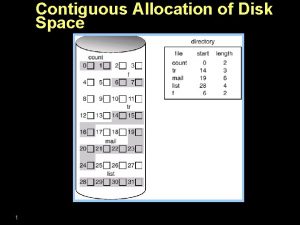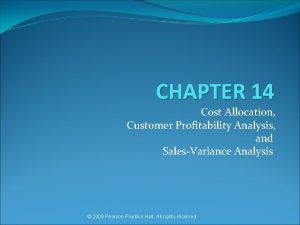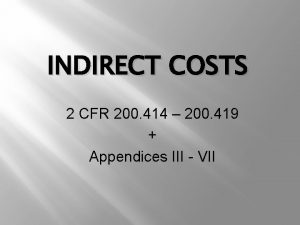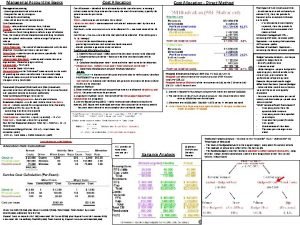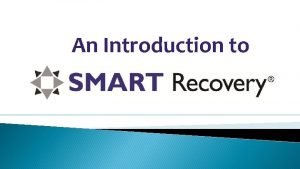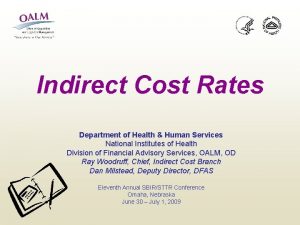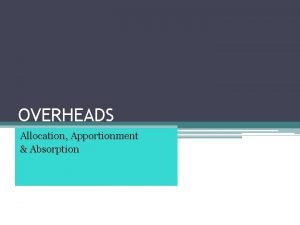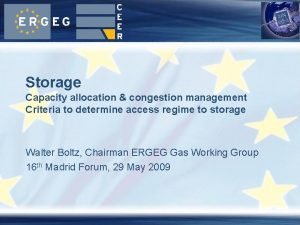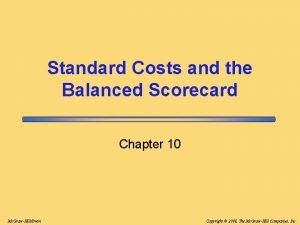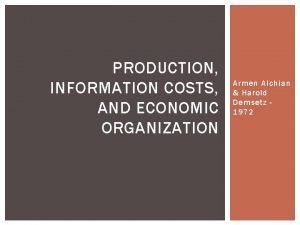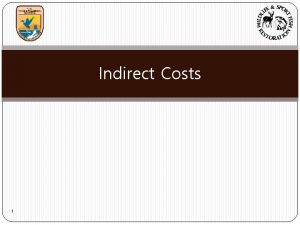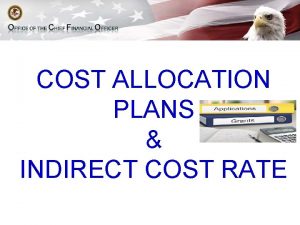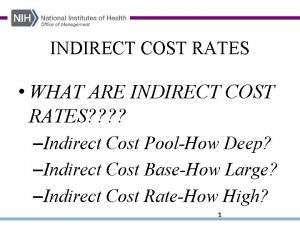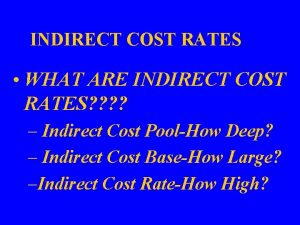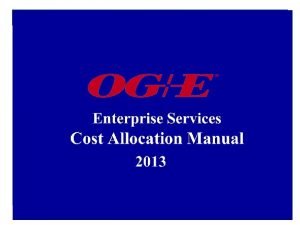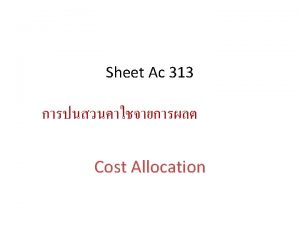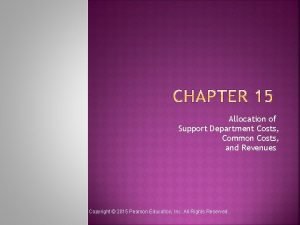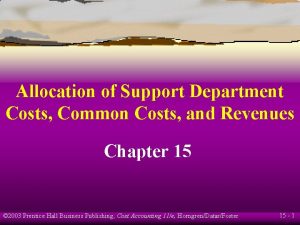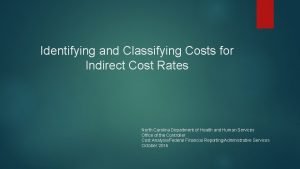Cost Allocation and Indirect Costs SMART 3 0































































- Slides: 63

Cost Allocation and Indirect Costs SMART 3. 0 Training November 14, 2019

Today’s Speakers Debbie Strama Charlie Watts Fiscal Policy Unit Supervisor Accountant, DFMAS U. S. Department of Labor, OGM DPRR U. S. Department of Labor – Region 4 Chicago, IL Dallas, TX Strama. Deborah@dol. gov Watts. Charles@dol. gov 2

SMART 3. 0 Training Strategies S M A R T Strategies Monitoring Accountability Risk Mitigation Transparency SMART 3. 0 Training Series: The training modules are focused on: Strategies for sound grant management that includes: Monitoring, Accountability, Risk mitigation and Transparency These four themes are weaved throughout the OMB Uniform Administrative Requirements, Cost Principles, and Audit Requirements for Federal Awards also known as the Uniform Guidance (2 CFR Part 200 and 2 CFR Part 2900). 3

Grant Management Toolbox 4

Module Overview ü Uniform Guidance requirements and definitions ü Cost Allocation ü Indirect Costs ü Cost Allocation Plans ü De Minimis Rate 5

Uniform Guidance Requirements & Definitions 6

Types of Costs ü Direct Costs ►Program ►Administrative ü Indirect Costs ►Program ►Administrative 7

What are Direct Costs? Those costs that can be easily identified with a particular cost objective (2 CFR 200. 413). Examples are costs that are specific to a single program: ü Salaries for a case manager who only works with your grant or participants ü Square footage of space occupied by program staff ü Supplies used by the case manager and program staff 8

What are indirect costs? Costs incurred for common or joint purposes, benefiting more than one cost objective, and are not readily identifiable to a specific cost objective. ü Administrative Salaries ü Executive Director Salary* ü Administrative space and operational expenses ü Staff working on multiple programs and unable to direct charge 9

Calculation - Indirect Cost Rate Indirect Costs ----------- = RATE Direct Costs 10

Simple Example - Rent and Utilities for 3 Grants 11

Simple Example – Office or One Stop Center Reception Costs for 3 Grants 12

Knowledge Check – Questions ü Which of the following are direct costs? ► A. Supplies used by a case manager (who only works with your grant participants) ► B. Salaries of Administrative staff ► C. Space occupied by the accounting staff ► D. Square footage of space occupied by a case manager (who only works with your grant participants) ► E. A and D 13

Knowledge Check – Answers ü Which of the following are indirect costs and which are direct costs? ► A. Supplies used by a case manager (who only works with your grant participants) Direct Cost ► B. Salaries of Administrative staff Indirect Cost ► C. Space occupied by accounting staff Indirect Cost ► D. Square footage of space occupied by a case manager (who only works with your grant participants) Direct Cost ► E. A&D (ANSWER E) 14

Cost Allocation 15

Cost Allocation – Definition 2 CFR 200. 4 Cost Allocation means the process of assigning a cost, or a group of costs, to one or more cost objective(s), in reasonable proportion to the benefit provided or other equitable relationship. The process may entail assigning a cost(s) directly to a final cost objective or through one or more intermediate cost objectives. 16

Allocable Costs 2 CFR 200. 405 ü Allocable Costs A cost is allocable to a particular Federal award or other cost objective if the goods or services involved are chargeable or assignable to that Federal award or cost objective in accordance with relative benefits received. Criteria for meeting this standard: ü Is incurred specifically for the Federal award ü Benefits both the Federal award and other work of the non-Federal entity, and ü Can be distributed in proportions that may be approximated using reasonable methods ü Necessary to the overall operation of non-Federal entity, and assignable, in part, to the Federal award in accordance with UG cost principles 17

Cost Objectives – Citations ü 2 CFR 200. 28 Cost Objective ► A program, function, activity, award, organizational subdivision, contract, or work unit for which cost data are desired ü 2 CFR 200. 60 Intermediate Cost Objective ► A cost objective used to accumulate indirect or service-center costs that are subsequently allocated to one or more indirect cost pools or final cost objectives ► Example: WIOA One-stop’s facilities costs (rent, utilities, repairs and maintenance costs, etc. ) ► Cost Pools or “Cost Staging Areas” 18

Cost Objectives ü 2 CFR 200. 44 Final Cost Objective ► Both direct and indirect costs are allocated to it ► One of the final accumulation points: an award, internal project, other direct activity ► Cost assigned to funding source › Example: shared youth costs ► And Cost Category of benefiting program/project › “Final resting place” › Example: WIOA Youth and Youthbuild 19

Cost Pooling ü Direct charge costs to a final cost objective when possible ü When that is not possible or practical, use an intermediate cost objective (cost pool) ► For any type of cost or grouping of similar costs not readily identified with a single final cost objective (Example: case management function; salaries, space cost, supplies, etc. ) ► Ultimately allocated to final cost objectives in proportion to the relative benefits received (Example: WIOA Adult, DW, Youth programs) ► Limited to shared direct and indirect costs ► Only actual, not budgeted, costs may be pooled when being charged to awards ► All costs in the pool must be allowable costs for all the cost objectives to which the pooled costs will subsequently be allocated 20

Measuring Benefit ü Costs are allocable to a particular cost objective to the extent of relative benefits provided to that cost objective ► If no benefit received, then it is not allocable to that objective ü Method used for measuring benefit is an integral part of the process for allocating costs ► The method used is the allocation base ü Costs pooled or assigned to intermediate cost objectives must be allocated to final cost objectives using an acceptable allocation base 21

Treatment of Costs ü Direct Charge Whenever Possible ü Consistent Treatment ► In Accounting System ► Over Time ü Measuring Benefit ► Benefit Determines Allocation 22

Cost Allocation Methods ü Cost Allocation Plan (CAP) ► Direct Costs ► Indirect Costs for Government entities ü Negotiated Indirect Cost Rate (ICR) ► Indirect Costs ü De Minimis Rate ► Indirect Costs 23

Shifting of Costs ü Any cost allocable to a particular Federal award under the principles provided for in this part may not be charged to other Federal awards to overcome fund deficiencies, to avoid restrictions imposed by Federal statutes, regulations, or terms and conditions of the Federal awards[2 CFR 200. 403(d)], or for other reasons. ü This prohibition would not preclude the grant recipient from shifting costs that are allowable under two or more Federal awards in accordance with existing Federal statutes, regulations, or the terms and conditions of the Federal awards. [2 CFR 200. 405(c)] 24

Indirect (F&A) Costs Defined 2 CFR 200. 56 ü Indirect (Facilities & Administrative) costs ► Costs incurred for a common or joint purpose benefitting more than one cost objective, and not readily assignable to the cost objectives specifically benefitted, without effort disproportionate to the results achieved. ► To facilitate equitable distribution of indirect expenses to the cost objectives served, it may be necessary to establish a number of pools of indirect (F&A) costs. ► Indirect (F&A) cost pools must be distributed to benefitted cost objectives on bases that will produce an equitable result in consideration of relative benefits derived. 25

Indirect (F&A) Costs 2 CFR 200. 414 ü Facilities ► Defined as depreciation on buildings, equipment and capital improvement, interest on debt associated with certain buildings, equipment and capital improvements, and operations and maintenance expenses. ü Administration ► Defined as general administration and general expenses such as the director’s office, accounting, personnel and all other types of expenditures not listed specifically under one of the subcategories of Facilities. 26

Indirect Costs at end of POP and Grant Closeout ü Indirect costs are reportable in section 13 of the FINAL ETA-9130 ü Unrecovered indirect costs… may be included as part of cost sharing or matching only with the prior approval of the DOL Grant Officer (Federal awarding agency). 2 CFR 200. 306(c) ü If you use a provisional indirect cost rate during the grant period of performance but receive a different final rate at grant closeout, you should make adjustments to expenses and submit an amended closeout package. 27

Administrative Costs as defined in WIOA 20 CFR 683. 215 Per WIOA: Costs associated with carrying out administrative and general management functions: › › › › › Accounting, budgeting, financial and cash management functions; Procurement and purchasing functions; Property management functions; Personnel management functions; Payroll functions; Coordinating the resolution of findings arising from audits, reviews, investigations and incident reports; Audit functions; General legal services functions; Developing systems and procedures, including information systems, required for these administrative functions; and Fiscal agent responsibilities; 28

Administrative Costs - 2 Desk-aids https: //grantsapplicationandmanagement. workforcegps. org/resources/2018/08/01/15/57/WIOASpecific-Resources 29

Knowledge Check 2 – Questions True or False? 1. In order for a cost to be allocable it needs to be able to be distributed in proportions that may be approximated using reasonable methods. 2. It is best to charge costs to an intermediate cost pool whenever possible. 3. Monitoring, audits, investigations, and incident reports are all examples of program costs. 30

Knowledge Check 2 – Answers 1. In order for a cost to be allocable it needs to be able to be distributed in proportions that may be approximated using reasonable methods. True 2. It is best to charge costs to an intermediate cost pool whenever possible. False 3. Monitoring, audits, investigations, and incident reports are all examples of program costs. False 31

Cost Allocation Plans 32

Cost Allocation Plan (CAP) – Definition ü What is a cost allocation plan? ► A document that identifies, accumulates, and distributes allowable direct costs (or indirect costs for governmental organizations) and identifies the allocation methods used for distribution 33

Cost Allocation Plans Minimum requirements ü In writing ü Supported by formal accounting records ü Signed by authorized agency official ü Include a process for reconciliation and adjustment ü Periodically validated and updated Costs should then be allocated in accordance with the methodology contained in the CAP 34

CAP Elements ü Background and mission statement, including organizational chart ü Description of the types of services provided ü Copies of financial statements and current budgets ü Shared expenses included in the cost of services to be allocated ü Allocation bases used for distributing expenses to benefitting cost objectives ü Certification by authorized official 35

Standards for Acceptable Bases ü Related to the types of costs being allocated ü Fair measure of cost generation or benefit ü Results in equitable allocation of costs ü Minimal distortion ü Actual effort or cost ü General acceptability ü Cost-effective use of available and representative data ü Timely management control ü Adjusted for variations in funding and services provided 36

Unacceptable Allocation Bases ü Funds available ü Plans, budgets or estimates not adjusted for actual costs ü Non-contemporaneous data such as results from prior periods ü Job descriptions ü Number of staff hours budgeted to an activity not adjusted to actual hours ü Planned expenditure levels ü Planned participant levels 37

Using Inputs as the Base Inputs ü Resources used; examples and documentation ü Number of employees - staffing plan ü Number of transactions - transactions count ü Direct labor hours - timesheets/Personal Activity Reports ü Space usage - floor plan showing space used by program/function ü Traditional method of allocation ü Allocated at time of cost incurred ü Adjustments to plan ► How the input is being used ► How the usage varies 38

Using Outputs as the Base Outputs ü Work units or products completed ü Numbers served ü Results obtained ü Allocated at the end of the process or period of time ü Percent share of expenditures ü Documentation ü Numerical counts ü Expenditure reports 39

Examples – Accounting Number of transactions, direct labor hours, allowable survey methods Auditing Expenditures audited, Direct audit hours Budgeting Direct labor hours Consumable Supplies Total direct costs, Direct labor hours Case Manager Number of current enrollees, Number of participants counseled, Direct labor hours Data Processing System usage, Direct labor hours Disbursing Service Number of checks issued, Direct labor hours 40

Examples – Intake Number of eligible participants, current period enrollments Equipment Number of employees, Direct labor hours, Direct expenditures Office Space Square feet of space occupied, Direct labor hours Payroll Services Number of employees Personnel Services Number of employees Postage Direct usage, Acceptable survey methods Reception and intake services Direct expenditures, Current enrollees 41

Knowledge Check 3 – Question ü Which of the following are acceptable allocation bases? ► A. Funds available ► B. Actual effort or cost ► C. Planned participant levels ► D. Job descriptions 42

Knowledge Check 3 – Answer ü Which of the following are acceptable allocation bases? ► A. Funds available ► B. Actual effort or cost ► C. Planned participant levels ► D. Job descriptions 43

Indirect Cost Rates 44

Indirect Cost Rates ü Why I would need a rate: ► Ensure equitable cost-sharing among all funding streams, Federal and non-Federal ► Means of charging administrative costs ► No rate needed if no indirect costs in budget ► A rate is required if recipient has a direct Federal cost reimbursable grant, has more than one funding stream or award, and will request reimbursement for indirect costs 45

Types of Bases Used to Determine ICR Direct salaries and fringe benefits Total direct costs Modified Total Direct Costs (MTDC) 46

Applying an Indirect Rate – Example Program 1 Approved NICRA Base Rate (Direct Salaries + Fringe Benefits Cost Pool) Calculated Indirect that could be recovered from Program 1 33% x $500, 000 $165, 000 47

Approved Rate Applies to All Grants ü All Federal agencies accept the rate as Federally approved for their grants as well ü Includes situations when the organization is a subrecipient of another grant ü Actual allowable charges may be limited Grant budget ► Cost limitations ► Federal regulations ► Available funds ► 48

Cognizant Federal Agency (Direct Recipient) 2 CFR 200. 19 Cognizant agency for indirect costs ü The Federal agency responsible for reviewing, negotiating, and approving cost allocation plans or indirect cost proposals on behalf of all Federal agencies ü ICR proposal submitted to the cognizant Federal agency. ü Largest dollar volume of direct Federal funding (normally) determines the cognizant agency. Concept flows down to state, local, or other levels of funding. ü HHS is cognizant for all States’ Statewide Indirect Cost Allocation Plans (SWICAP) and for most educational institutions; for info: http: //rates. psc. gov/ ü If DOL recipient, visit Division of Cost Determination (DCD) link for info: http: //www. dol. gov/oasam/boc/dcd/ 49

De Minimis Rate 50

De Minimis Rate ü 2 CFR 200. 414(f) An eligible entity ►Has indirect costs; never received a negotiated indirect cost rate ►May charge 10% of modified total direct costs (MTDC) for an indefinite period ü Non-eligible entity ►Had a previously negotiated indirect cost rate or approved cost allocation plan ►Governmental units with more than $35 million in direct Federal funding 51

Modified Total Direct Costs (MTDC) ü Actual salaries, wages, fringe benefits, materials and supplies, services, travel; subawards up to the first $25, 000 of each subaward MTDC Exclusions ü Equipment, capital expenditures, patient care, rental costs, tuition and participant support costs ü Portion of each subaward in excess of $25, 000 ü Other items may be excluded by Federal cognizant agency 52

De Minimis Rate Applied 53

Common Mistakes ü Unacceptable bases used to distribute costs ü Bases used do not best allocate cost based on benefits received ü Not having a cost allocation plan (CAP) or indirect cost rate (ICR) ü Not allocating costs in accordance with the CAP or ICR ü Non-grant activities not receiving their fair share of costs 54

Module Review ü Cost Allocation ü Indirect Costs ü Cost Allocation Plans ü De Minimis Rate 55

Questions? 56

Core Monitoring Guide – Objective 3. g Cost Allocation/Indirect Costs ü Indicator 3. g. 1: Cost Allocation Principles ► Does the grant recipient have written policies and procedures for distributing program costs, staff time, and general administrative costs among funding streams, programs, etc. ? ü Indicator 3. g. 2: Cost Allocation Plan ► Does the grant recipient have an approved CAP? Is it the authorized party to that CAP? ü Indicator 3. g. 3: NICRA ► Does the grant recipient have an approved rate specific to its organization? ü Indicator 3. g. 4: De Minimis ► Did the grant recipient correctly calculate the MTDC? Did the grant recipient correctly apply ten percent to the MTC base? 57

SMART Checklist ü Cost Allocation Plans and Indirect Costs q Update policies to require written evidence of costs being allocated to the grant are allowable, being treated consistently over time and within the accounting system, are necessary, reasonable, and allocated to the grant based on benefit received. [2 CFR 200. 403] q Create or update policies on the allocation of indirect costs and shared direct costs where necessary and applicable. q Develop or update policies to ensure that a indirect cost proposal or CAP used for distributing indirect costs contains the elements required in the Uniform Guidance. 58

SMART Checklist (cont. ) q Install a process to evaluate and update the distribution bases and cost allocation methodologies to ensure that shared costs are allocated to programs or activities on an equitable or proportionate share. q Update or create a policy to obtain the approval by the Federal cognizant agency or the PTE for the allocation of indirect costs or accept a subrecipients Federally approved indirect cost rate, or negotiated and approve a rate for subrecipients without a Federally approved rate. q Develop or update formalized policies to request and submit a de minimis ICR, if applicable, or determine a subrecipient’s eligibility for the de minimis, if applicable. 59

ETA and Uniform Guidance Resources ü Core Monitoring Guide ► Objective 3. g Cost Allocation Plans and Indirect Costs ü Grant & Financial Management Technical Assistance Guide ► Chapter 10: Cost Allocation Plans ü Funding for the One-Stop System Technical Assistance Guide ► Chapter 5 Cost Allocation ü Uniform Administrative Requirements, Cost Principles, and Audit Requirements for Federal Awards 2 CFR Part 200 ► ► ► ► ► 2 CFR 200. 4 2 CFR 200. 19 2 CFR 200. 28 2 CFR 200. 44 2 CFR 200. 56 2 CFR 200. 60 2 CFR 200. 306 2 CFR 200. 403 2 CFR 200. 405 2 CFR 200. 413 60

Web Resources ü What is the best way to find your local American Job Center (AJC)? ► See DOL’s Service Locator ü Want More Information? ► DOLETA. gov/Grants • Funding Opportunities • How to Apply • Manage Your Awarded Grant • Resources and Information § ETA Grantee Handbook § Annual Grant Terms Template § Core Monitoring Guide § Technical Assistance Guides § Uniform Guidance Quick Reference Sheet ü Want More Training? Workforce GPS’s Grants Application and Management Community of Practice • Financial Reporting • Subrecipient Management and Oversight • Indirect Cost Rates • Policies and Procedures • Procurement and Performance. Based Contracts • Capital Assets and More ► Workforce. GPS ► 61

Remember the Grant Management Toolbox! 62

Thank you. This presentation was developed using Federal funds for training purposes and cannot be used by third parties to earn money or fees. 63
 Linked allocation
Linked allocation Cost allocation and profitability analysis
Cost allocation and profitability analysis Cost incurrence
Cost incurrence 2 cfr 200 indirect costs
2 cfr 200 indirect costs Indirect costs
Indirect costs Cloud cost allocation
Cloud cost allocation Support department adalah
Support department adalah Cost allocation direct method
Cost allocation direct method The correct cost flow in a job order costing system is:
The correct cost flow in a job order costing system is: Street knowledge vs book knowledge
Street knowledge vs book knowledge One smart man he felt smart
One smart man he felt smart Interserf
Interserf Ways to pay future smart answers
Ways to pay future smart answers Eight types of intelligence
Eight types of intelligence Kim ung-yong
Kim ung-yong Street smart vs book smart quotes
Street smart vs book smart quotes One smart man he felt smart
One smart man he felt smart Difference between direct and indirect cost
Difference between direct and indirect cost Cost accumulation and cost assignment
Cost accumulation and cost assignment Cost accumulation and cost assignment
Cost accumulation and cost assignment Cost accumulation and cost assignment
Cost accumulation and cost assignment Cost accumulation and cost assignment
Cost accumulation and cost assignment Dennis geyer
Dennis geyer Standard costs are
Standard costs are Distinguish between average cost and marginal cost
Distinguish between average cost and marginal cost Cost control and cost reduction difference
Cost control and cost reduction difference Process costing vs job order costing
Process costing vs job order costing Ordering cost and carrying cost
Ordering cost and carrying cost Opportunity cost vs trade off
Opportunity cost vs trade off Cost control and cost reduction project report
Cost control and cost reduction project report Cost control and cost reduction project report
Cost control and cost reduction project report The relative proportion of variable fixed or mixed
The relative proportion of variable fixed or mixed Smart meter cost benefit analysis
Smart meter cost benefit analysis Cost benefit analysis smart recovery
Cost benefit analysis smart recovery Smart recovery cba
Smart recovery cba Direct vs indirect questions
Direct vs indirect questions Recruiting for international assignments
Recruiting for international assignments Nih sbir indirect cost rate
Nih sbir indirect cost rate 10% de minimis indirect cost rate uniform guidance
10% de minimis indirect cost rate uniform guidance Account receivable
Account receivable Manufacturing cost vs non manufacturing cost
Manufacturing cost vs non manufacturing cost Job costing and process costing
Job costing and process costing Flotation cost in cost of equity
Flotation cost in cost of equity Cost concept and classification
Cost concept and classification Manufacturing cost vs non manufacturing cost
Manufacturing cost vs non manufacturing cost Standard cost vs budgeted cost
Standard cost vs budgeted cost Opportunity cost of equity capital
Opportunity cost of equity capital Literal cost gate input cost
Literal cost gate input cost Literal cost gate input cost
Literal cost gate input cost Literal cost gate input cost
Literal cost gate input cost Resources allocation and mobilization plan (ramp)
Resources allocation and mobilization plan (ramp) Functionalist views on education
Functionalist views on education Disadvantages of dynamic memory allocation
Disadvantages of dynamic memory allocation Resource allocation and scheduling
Resource allocation and scheduling Resource allocation graph and wait for graph
Resource allocation graph and wait for graph Financial markets and the allocation of capital
Financial markets and the allocation of capital Capital allocation between risky and risk-free assets
Capital allocation between risky and risk-free assets Allocation apportionment and absorption of overheads
Allocation apportionment and absorption of overheads What is order promising
What is order promising Capacity allocation and congestion management
Capacity allocation and congestion management Voev-inc
Voev-inc What are the impacts of resource constrained scheduling
What are the impacts of resource constrained scheduling Chapter 18 responsibilities and costs of credit
Chapter 18 responsibilities and costs of credit Production, information costs, and economic organization
Production, information costs, and economic organization
